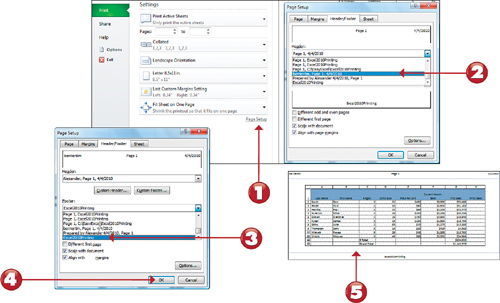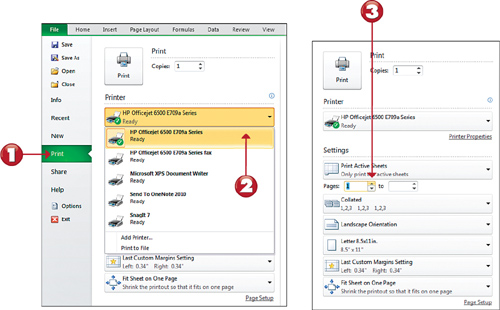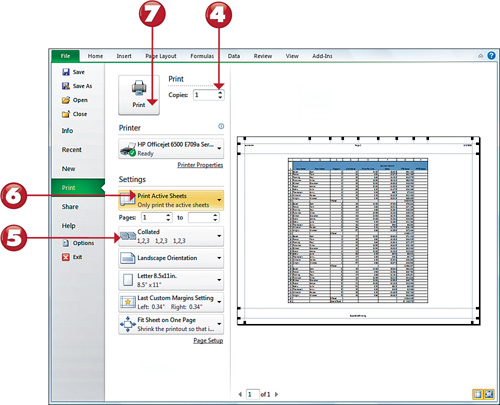Adding Headers and Footers
Headers
and footers appear at the top and bottom of printed pages of Excel
worksheets and can display the filename, the date and time the worksheet
was printed, and the worksheet’s name, or you can create your own
custom header or footer.

1. Go to the Print pane in the Backstage View and click the Page Setup link.
2.
On the Header/Footer tab, click the down arrow next to the Header
field, and scroll through the header options. If you see one you like,
click it to see what it looks like.
3.
Click the down arrow next to the Footer, and scroll through the footer
options. If you see one you like, click it to see what it looks like.
4. Click OK.
5.
You can view the worksheet in Print Preview mode to get an idea of what
your printed worksheet will look like with headers and footers.
Printing Worksheets
Printing
a worksheet, workbook, or chart sheet is quite simple, but setting the
options for printing can be complex. The number of options that must be
set before printing depends on the amount of data stored in the
workbook, how it is arranged, how much of it needs to be printed, and
how you want the printout to look.

1. Go the File tab and click Print.
2. Click the down arrow next to the Printer Name field to choose the printer or fax you want to use.
3. In the Print range area, click Page(s) From and To, and type the pages you want to include in the range (for example, from 2 to 5) or keep the All (default).
Note: Vertical or Horizontal Page Order
If
you work with a large worksheet, you can specify the page order for your
worksheet. Go to the Page Layout tab and click the Page Setup dialog
launcher. Once the Page Setup dialog box activates, you can click on the
Sheet tab. Review the options of Down, then over (default) and Over,
and then down in the Page order area of the Page Setup dialog box. |
Note: Setting Additional Print Options
To set
additional print options, such as the paper size, graphic options, font
options, and printer details, click the Printer Properties link in the
Print section of Backstage view. |

4. Type the number of copies you want to print in the Number of Copies field, which defaults to 1.
5. If you want the printed pages to be collated, click the Collate drop-down to set that option.
6.
In the Settings group, click either Selection (only selected cells),
Active Sheet(s) (currently sheets), or Entire workbook (all worksheets
and chart sheets).
7. Click the Print button to send your printout to the printer.
Tip: Quick Printing
You can
add the Quick Print command to your Quick Access Toolbar. This allows
you to print your entire worksheet without going to the Backstage View.
|